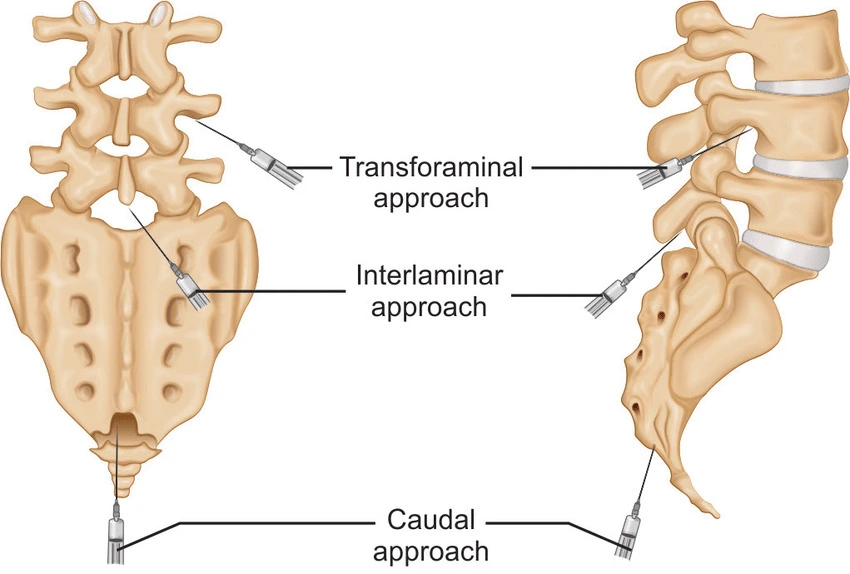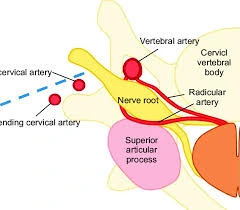One of the most frequent injections I perform is a transforaminal epidural steroid injection. I’m often asked by patients, particularly women, “Is this like an epidural when you have a baby?” And I get to explain that it’s really something altogether different.
If you’re considering or have been recommended a transforaminal epidural steroid injection, understanding the differences between this procedure and other types of epidural injections is essential. Let’s dive into what makes this procedure unique, its benefits, and how it compares to other epidural injections.
Exploring Transforaminal Epidural Steroid Injections
A transforaminal epidural steroid injection (TFESI) is a targeted procedure designed to deliver anti-inflammatory medication directly to the area of nerve irritation. This treatment is commonly used to address conditions such as:
- Herniated discs
- Spinal stenosis
- Sciatica
- Radiculopathy (nerve pain radiating down the arm or leg)
Unlike a traditional epidural used during labor or general pain management, TFESI involves injecting medication near a specific spinal nerve root through a natural opening in the spine called the foramen. This precision helps to reduce inflammation and pain at the exact source of the problem.
Labor Epidural vs. Transforaminal Epidural Steroid Injection
Patients often confuse a labor epidural with a TFESI, but they are entirely different procedures with distinct purposes. A labor epidural aims to provide pain relief during childbirth by numbing a larger area of the lower body. In contrast, a TFESI targets a specific nerve root to reduce localized inflammation and pain caused by conditions like sciatica or herniated discs. Understanding these distinctions can help patients feel more confident and informed about their treatment options.

Labor Epidural
- Administered to provide pain relief during childbirth.
- Involves injecting anesthetic medication into the epidural space around the spinal cord.
- Creates a widespread numbing effect, typically affecting both legs and lower back.
- Performed without fluoroscopic (X-ray) guidance.
Transforaminal Epidural Steroid Injection
- Administered to reduce nerve inflammation and pain caused by spinal conditions.
- Involves injecting anti-inflammatory steroids near a specific nerve root.
- Requires fluoroscopic guidance to ensure precise placement of the needle and medication.
- Targets one side of the body, depending on the affected nerve.
Interlaminar Epidural Steroid Injection vs. Transforaminal Epidural Steroid Injection
While both interlaminar and transforaminal injections involve delivering steroids to the epidural space, their techniques and purposes differ significantly. Interlaminar injections are designed to treat broader areas of pain by spreading medication widely across the epidural space. In contrast, transforaminal injections precisely target the specific nerve root causing pain, making them highly effective for localized conditions such as sciatica or radiculopathy. Additionally, transforaminal injections offer diagnostic utility by helping to confirm the source of pain. By observing the patient’s response to the injection, physicians can pinpoint the nerve root involved, guiding further treatment decisions. This distinction ensures that each procedure is tailored to the unique needs of the patient’s condition.

Interlaminar Epidural Steroid Injection
- The needle is inserted through the midline of the back into the epidural space.
- The medication spreads across a broader area of the spine.
- Often used for more generalized pain or when the source of the pain is unclear.
Transforaminal Epidural Steroid Injection
- The needle is inserted through the foramen, targeting the specific nerve root causing pain.
- The medication is delivered precisely to the area of inflammation.
- Provides more targeted relief compared to an interlaminar injection.
Lumbar vs. Cervical Transforaminal Epidural Steroid Injection
The location of the injection—whether in the lumbar (lower back) or cervical (neck) spine—affects both the procedure and the precautions taken. For lumbar injections, the procedure typically involves accessing a larger foramen and allows for the safe use of particulate steroids, providing longer-lasting relief. In contrast, cervical injections require navigating smaller spaces and avoiding particulate steroids due to the proximity of critical blood vessels and nerves, which increases the risk of complications. These differences necessitate specific techniques and safety protocols tailored to the injection site to ensure optimal outcomes.
Lumbar Transforaminal Epidural Steroid Injection
- Performed for conditions like sciatica or lumbar radiculopathy.
- Typically well-tolerated with minimal risk.
- Particulate steroids (medications that stay longer in the area) can be safely used in many cases.
- Sedation is sometimes offered for patient comfort, though not always necessary.
Cervical Transforaminal Epidural Steroid Injection
- Performed for conditions like cervical radiculopathy or arm pain.
- More technically challenging due to the smaller space and proximity to critical blood vessels and nerves.
- Key Precaution: Particulate steroids are avoided because they can increase the risk of serious complications, such as stroke.
- Sedation is minimized or avoided to allow the patient to communicate and ensure safety during the procedure.

Why Fluoroscopic Guidance Matters
Both lumbar and cervical transforaminal epidural steroid injections are performed under fluoroscopic guidance. This real-time X-ray imaging ensures:
- Accurate needle placement, which minimizes the risk of complications and improves the procedure’s effectiveness.
- Minimal risk of injury to surrounding tissues, such as blood vessels, nerves, or nearby structures.
- Precise delivery of medication to the targeted nerve root, ensuring optimal pain relief and reducing inflammation.
- Enhanced safety, as the live imaging allows the physician to adjust and confirm the needle’s placement dynamically.
In addition to fluoroscopy, contrast dye plays a vital role in ensuring the safety and accuracy of the procedure. The contrast dye helps highlight the epidural space and the nerve root on the X-ray, confirming that the medication is delivered precisely to the intended location. For patients with an allergy to iodine-based contrast dyes, alternative options such as gadolinium can be used. Alternatively, a test dose of a short-acting local anesthetic with epinephrine may be administered to ensure the injection is safe and effective. These precautions are integral to providing a personalized and safe approach to each patient’s treatment.
Benefits of a Transforaminal Epidural Steroid Injection
- Targeted Pain Relief: Directly addresses the source of nerve inflammation.
- Minimally Invasive: Avoids the need for surgery in many cases.
- Quick Recovery: Most patients return to normal activities the same day.
- Diagnostic Value: Helps confirm the source of pain by observing the patient’s response to the injection.
What to Expect During and After the Procedure
During the Procedure:
- You’ll lie face down on a procedure table for a lumbar transforaminal injection. Face up for a cervical transforaminal.
- A local anesthetic will numb the injection site.
- Fluoroscopy will guide the needle to the target nerve root.
- The steroid medication and possibly a small amount of anesthetic are injected.
After the Procedure:
- Mild soreness at the injection site is normal.
- Pain relief may occur immediately or within a few days as the steroid reduces inflammation.
- Activity restrictions are minimal, but you should avoid strenuous exercise for 24 hours.
Is a Transforaminal Epidural Steroid Injection Right for You?
If you’re struggling with persistent nerve pain, a transforaminal epidural steroid injection may provide significant relief. This procedure is most effective when part of a comprehensive treatment plan that may include physical therapy, medications, or other interventions.
A transforaminal epidural steroid injection is not the same as a labor epidural or interlaminar epidural injection, it is a powerful tool for treating nerve-related pain. Understanding the differences and benefits can help you make an informed decision about your care.
If you’re ready to explore this treatment option, call Red Butte Pain Solutions at 602-633-4334. Our team specializes in targeted, minimally invasive pain relief techniques to help you regain your quality of life.
